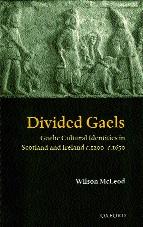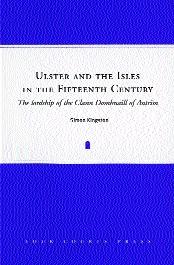Divided Gaels: Gaelic cultural identities in Scotland and Ireland c. 1200–c. 1650
Published in Early Modern History (1500–1700), Gaelic Ireland, Issue 3 (Autumn 2004), Medieval History (pre-1500), Reviews, Volume 12Divided Gaels: Gaelic cultural identities in Scotland and Ireland c. 1200–c. 1650
Wilson McLeod
(Oxford University Press, £50)
ISBN 0 199 247226
Ulster and the Isles in the fifteenth century: the lordship of the Clann Domhnaill of Antrim
Simon Kingston
(Four Courts Press, £55)
ISBN 1 851 827293
 In the wake of the establishment of a Scottish regional parliament, Scottish–Irish relations have begun to receive a lot more attention from historians. Both of these books are examples of this recent interest, though contrasting in their approaches and source material.
In the wake of the establishment of a Scottish regional parliament, Scottish–Irish relations have begun to receive a lot more attention from historians. Both of these books are examples of this recent interest, though contrasting in their approaches and source material.
Excellent work has long been done on the medieval kingdom of Scotland, based on central administrative records of the standard Anglo-Norman type, but Gaelic language sources, bardic poetry, genealogies and late seventeenth- or eighteenth-century traditional family histories, which provide the most detailed information for the highlands and islands, have until recently been left largely to the students of literature and folklore. Popular myths have abounded, and have been treated with undeserved respect in the course of scholarly controversies. McLeod’s work is a breath of fresh air in this respect. He concentrates on bardic poetry, as the only Gaelic language source available in substantial quantities that is fully contemporary with its subject matter, and uses it not to establish facts but to assess attitudes—how the medieval Gaels of Scotland and Ireland viewed each other. He is in control of his sources, he is enormously well read and up-to-date in the secondary literature, and draws only cautious and unprejudiced conclusions, firmly anchored in substantiating evidence.
This is a history of ideas rather than a detailed political narrative or an appreciation of the bardic poetry as literature. At the outset he sketches in the historical background to the interaction of Ireland and Scotland from the colonisation of south-western Scotland by the Irish kingdom of Dál Ríata in about the fifth century. He traces the spread of the Gaelic language in Scotland, and then its decline in the south and east from the mid-twelfth century. The English dialect of Lowland Scots became the language of court and towns, with Gaelic being confined to the area west and north of the ‘Highland Line’ from at least the late fourteenth century, paralleling the division of Ireland into Gaeltacht and Galltacht. Over the same twelfth- to fourteenth-century period, Scots Gaelic expanded westwards to replace Norse in the Hebrides, especially after 1266, when the Western Isles were transferred from Norway to the Scottish crown. Fresh links formed between the Gaels of Western Scotland and Ireland through the advent of the Scottish mercenaries, or galloglasses, to Ireland in the late thirteenth century, followed by the Bruce invasion of Ireland in 1315–18, the marriage between the younger brother of the MacDonald Lord of the Isles and the Bisset heiress to the Glens of Antrim c. 1400, and the fresh importation of seasonal armies of Islesmen, the Redshanks, by sixteenth-century Irish chiefs struggling against the Tudor reconquest. McLeod ends his account before the Ulster plantation, when the influx of large numbers of Lowland Scots-speaking planters and new religious differences changed the nature of Ireland’s interaction with her nearest neighbour.
 His chapter on ‘Literary and intellectual culture in the Gaelic world’ deals as much with contrasts between Ireland and Scotland as with their common heritage. Much less medieval bardic verse has survived in Scotland than in Ireland, and a greater proportion is the work of half-trained ‘bards’ rather than the fully trained court poets, or filidh, perhaps because the smaller political units represented by the Scottish clans could not afford to maintain fully trained professional poets. The verse of the home-educated bards reflected local trends and preoccupations, rather than ‘international’ Gaelic culture. Only three major families of Scottish filidh are recorded, all of whom may be of Irish origin. While the filidh might travel backwards and forwards between Ireland and Scotland seeking education or patronage, the numbers known to have done this are quite small. Manuscript texts of sagas and romances circulated freely, though significantly in such tales ‘the imagined landscape remained Hiberno-centric . . . the principal heroes never seem to be Scottish’.
His chapter on ‘Literary and intellectual culture in the Gaelic world’ deals as much with contrasts between Ireland and Scotland as with their common heritage. Much less medieval bardic verse has survived in Scotland than in Ireland, and a greater proportion is the work of half-trained ‘bards’ rather than the fully trained court poets, or filidh, perhaps because the smaller political units represented by the Scottish clans could not afford to maintain fully trained professional poets. The verse of the home-educated bards reflected local trends and preoccupations, rather than ‘international’ Gaelic culture. Only three major families of Scottish filidh are recorded, all of whom may be of Irish origin. While the filidh might travel backwards and forwards between Ireland and Scotland seeking education or patronage, the numbers known to have done this are quite small. Manuscript texts of sagas and romances circulated freely, though significantly in such tales ‘the imagined landscape remained Hiberno-centric . . . the principal heroes never seem to be Scottish’.
This imbalance is noted again in the chapter ‘Scotland and Ireland: the vision of bardic poetry’. Scottish chieftains are praised in verse for their royal descent from the prehistoric Irish brothers, the Three Collas, and compared to the Irish heroes Fionn and Cúchulainn. Early Dalriadic kings, who used to figure in Scottish Gaelic court verse before the twelfth century, are hardly mentioned in this later medieval bardic material, while the names of Irish high kings abound. Irish hospitality and Irish poetic learning are represented as summits of excellence to which Scottish patrons and poets can be compared by way of compliment. Irish bardic poets, on the other hand, saw Scotland as distant and separate, seldom referring to it unless addressing a Scottish patron, and stressing the barrier formed by the intervening stretch of sea. When complimenting Scottish patrons, Irish bards addressed them as exiles who should return to their Irish motherland (and claim the high kingship!).
In the fourth chapter McLeod traces the accentuation of these feelings of separation between the Gaels of Ireland and Scotland in the early modern period, partly as a side-effect of the Reformation, though this spread more gradually into the Highlands than is sometimes thought. For seventeenth-century Irish poets ‘there is no sense at all of Scotland as a last bastion of “Gaeldom”, surviving still after the disaster of Kinsale’. Scottish poets now refer rather to their own landscape and heroes, with little mention of Ireland. In conclusion, McLeod finds the concept of a single Gaelic ‘culture-province’ an unsatisfying description for any part of the period he has been reviewing, and rejects Steven Ellis’s view (Ireland in the age of the Tudors, 251) that ‘late medieval Gaeldom . . . thought more in terms of a Gaelic world . . . surrounded by Goill’ than of themselves as Irish or Scottish Gaels respectively. McLeod’s reversion to ‘national’ units for his framework of reference is tantamount to historical heresy these days, but he makes a convincing case.
Kingston’s study of the fifteenth-century MacDonnell lordship of the Glens of Antrim as a link between Ireland and Scotland should have provided the perfect complement to McLeod’s study. Like McLeod’s, his work is very fully footnoted, and it contains an extensive bibliography that provides Irish historians with a useful guide to relevant Scottish publications. He concentrates on the more traditional administrative records for his historical narrative, and has chosen to present this in three concurrent streams, detailing contemporaneous events in Gaelic Ulster, the kingdom of Scotland and the Lordship of the Isles. This is followed by chapters on the concept of Gaelic lordship or tigearnais [sic], the exercise of lordly power, and warfare and defence.
Alas, his account abounds in inaccuracies so marked as to amount to misinformation—for example, a ghostly figure, ‘Brian the Tánaise’ (d. 1419), appears on the O’Neill family tree, an erroneous doublet for Brian (d. 1319) who also appears on the diagram, but a touching account of this person’s death in the fifteenth century occurs on p. 137, thus misdating a feud between the Great O’Neill and Clann Aodha Buidhe by a hundred years. In a series of slips (pp 60–5) the third and fourth earls of Ormond are treated as one man, Toirdhealbhach of the Wine O’Donnell is confused with his grandson, and the grandson Toirdhealbhach O’Donnell and his uncle Neachtain are described as brothers. In his chapter on tighearnais (p. 143) he states that the pre-Christian Irish inauguration rite normally involved the king’s marriage to his ‘chosen bride’, in other words to an actual woman, as an embodiment of the sovereignty of his country. Alarmingly he cites me as his authority for this novel idea, no doubt misled by my use of the trendy term ‘woman of sovereignty’ to describe the supernatural figure of Medb or Eithne, because Celtic scholars hold that to call them ‘goddesses of sovereignty’ is to presuppose pagan beliefs on the part of Early Christian writers. Clearly I should stick to the less ambiguous phrase ‘supernatural being’ in future!
Setting aside these misunderstandings, there are also strange gaps in Kingston’s historical narrative. He ignores the role of the Savage family of the Ards in bringing the MacDonnells to the Glens, although Edmund Savage, seneschal of Ulster, was guardian to the heiress Marjorie Bisset who married Eoin MacDonnell, and Robert Savage married Eoin’s sister, Christiana of the Isles. Strangely, although the Scots were presumably introduced to strengthen the defences of the Anglo-Irish colonists, in 1404 they allied with the Irish of eastern Ulster in a ferocious war against the settlers in Lecale and the Ards, but Kingston does not discuss this either. In one curious passage (p. 69) he criticises his sources for insisting that Domhnall Ballach MacDonald returned to the Isles after the battle of Inverlochy in 1431, when according to Kingston ‘it seems likely that Domnall proceeded directly to the Glynns, and it is revealing that the pro-crown authors should fail to distinguish between the western isles and Ulster’. He gives no grounds for his disbelief in the chroniclers, even stating on p. 79 that ‘it is also apparent that Domnall did not simply retire to the Glens and remain there after 1431’, while on p. 102 he reiterates that ‘in 1431 [Domnall] would seem to have removed to Antrim in the immediate aftermath of the battle’. Nonetheless, its detailed treatment of an area and period too often neglected, accompanied by full scholarly apparatus, makes this a useful book, less perhaps as a reliable work of reference than as a stimulus to further research.
Katherine Simms
















